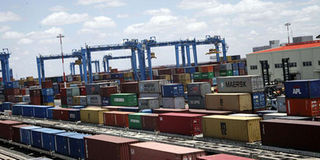SGR takes joy away from bus firms, cargo stations

This image taken on September 23, 2018 shows containers transported via the standard gauge railway stored at Inland Container Depot in Nairobi. Truck owners have lost business to rail. PHOTO | FILE | NATION MEDIA GROUP
What you need to know:
- Stakeholders in Mombasa fear the town will become a business shell as CFSs and transport firms scale down, as some move to Nairobi and Naivasha.
- This is blamed on the government’s move to compel importers to use trains to ferry their cargo so it can recoup the cost of building the railway.
As the standard gauge railway (SGR) turns two, the project has brought numerous socio-economic benefits, but it has also dealt a death blow to other businesses.
The initial phase of the project that runs from Mombasa to Nairobi has resulted in diminishing business and loss of income to container freight stations (CFSs), trucking and bus companies as well as clearing and forwarding agencies.
The SGR expects to haul close to nine million tonnes of cargo worth Sh5.08 billion per year, a monthly average Sh424 million.
Stakeholders in Mombasa fear the town will become a business shell as CFSs and transport firms scale down, as some move to Nairobi and Naivasha.
This is blamed on the government’s move to compel importers to use trains to ferry their cargo so it can recoup the cost of building the railway.
UNFAIR PRACTISES
This means that over Sh12.5 billion worth of investment in the 20 CFSs — where more than 800 trucks used to operate daily — might go to waste if the government does not give cargo owners a chance to choose how to ferry their cargo.
About 1,300 cargo containers arrive at the port daily. The government has offered lower freight tariffs to those using the SGR service, creating unfair competition as Nairobi begins to experience the boom.
Mr Johson Mutuku, a consultant with Stratton Consulting Ltd, said in an earlier interview that Mombasa County will lose Sh21 billion in business from truckers while CFSs are likely to lose Sh12 billion in missed container storage this year alone.
Bus firms based in Mombasa and its environs will also report declined revenues, Mr Mutuku said.
“SGR is good for business nationally, but it will cause a decline in revenues for many businesses in the Coast region. It is important for business people to adopt alternative businesses,” he said.
JOBLESS
Truck owners, the most hit by the introduction of freight trains, have decried loss of business with some planning to sell their trucks.
“My members have lost big in the SGR project. Drivers, loaders and turn-boys have lost jobs as most containers are being collected at ICD, Embakasi. We’re seeing a situation where transporters will be forced to move out of Mombasa since it is no longer viable,” Kenya Transport Association chief operations officer Mercy Ireri said, adding that the SGR has brought a curse to the sector with cargo owners complaining of delays in deliveries.
Clearance at the ICD in Nairobi is complex. “It takes more days for clients to get their cargo in Uganda compared to when it’s transported using trucks,” Ms Ireri said.
Transporters Workers Union secretary Nicholas Otieno said hundreds of jobs have been lost in the wake of the SGR freight transportation.
“The transport sector has been playing a major role in job creation in Mombasa. But in the last one year, jobs have been lost as transporters downscale on drivers and CFSs close down,” Mr Otieno said.
PASSENGERS
This has also affected truck spare parts shop owners, forcing them to close down, a trader said.
With passenger trains gaining pace, bus companies have been forced to improvise to survive, with a spot check by the Nation indicating they have introduced new routes away from the SGR line.
However, Shippers Council of East Africa chief executive Gilbert Langat insisted that there is sufficient business for both the SGR and other agencies.
“SGR as it is now probably carries about 18 per cent (of cargo). At maximum when they do 12 trains a day they will probably carry 32 to 35 per cent. Where does the remaining 65 per cent go to?”






